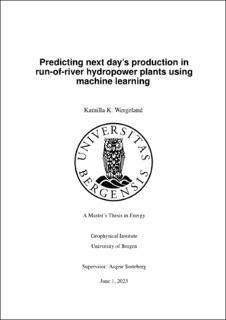| dc.description.abstract | This master thesis focuses on time series forecasting using machine learning to predict hourly production in run-of-river hydropower plants. As electrical energy cannot be easily stored, it must be produced and consumed at the same time. To balance production and consumption, power suppliers in Norway must report to Statnett their expected energy production for the following day. Run-of-river hydropower plants rely on the natural water flow in rivers and do not involve any storage. Therefore, the production must be estimated based on the prevailing weather and hydrological conditions. Accurate predictions are crucial to minimize imbalance fees and ensure grid stability. The main objective of this study is to enhance the accuracy of predictions compared to Småkraft AS’s current method. The study aims to answer three research questions related to the most significant time intervals for weather variables that affect production, the most important features for making predictions, and the model’s performance in various weather situations. Two of Småkraft’s power plants, Bjørgum power plant and Furegardane power plant, provide the data for testing three machine learning models: a random forest regressor, a multilayer perception neural network, and a long short-term memory neural network. Input data to the models include weather forecast and observational-based variables, along with engineered features such as accumulated rainfall and snowmelt. The study concludes that the long short-term memory neural network is the best model and outperforms the current method used by Småkraft at both locations. The findings suggest that machine learning models can significantly improve the accuracy of hydropower production forecasting, which can benefit hydropower plant operators as well as the stability of the electricity grid. One limitation of the model is that it requires years of historical data and consequently will not be suitable for newly established power plants. Future work could focus on using data from power plants with comparable location, production patterns, and climate to predict the production in the power plant of interest. | |
